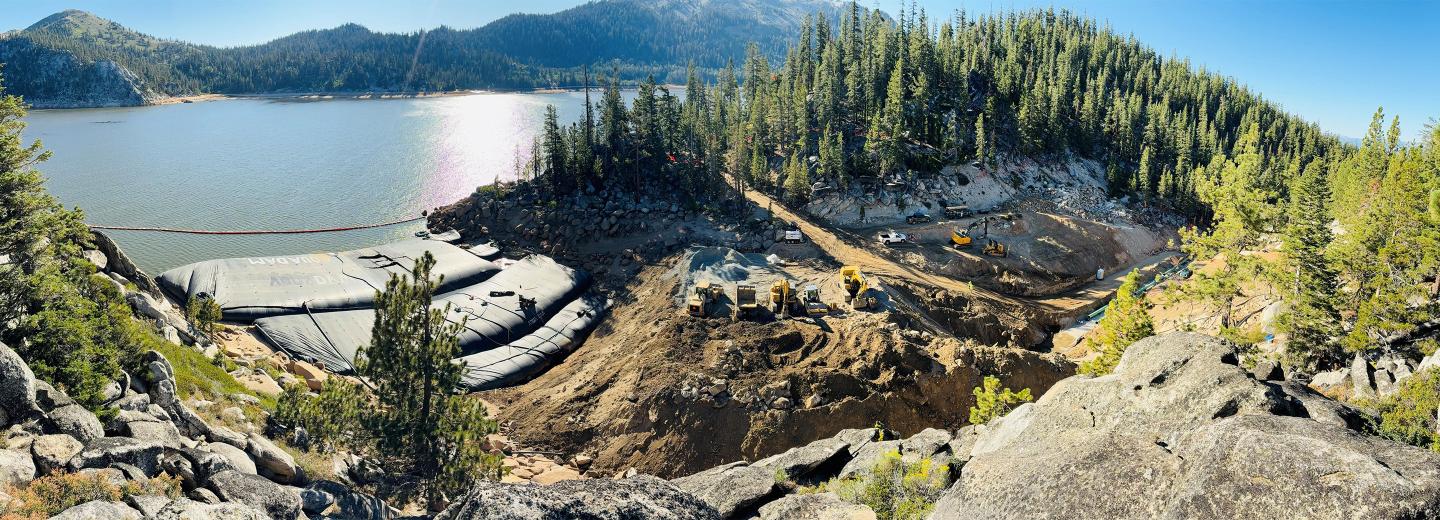
Marlette Lake Dam Project
On the eastern slopes of the Sierra Nevada Mountain Range sits the 152-year-old Marlette Lake Dam. Originally constructed in 1873 as a water supply for the homes and mines of a growing Virginia City, Marlette Lake still serves as a vital water source for Carson City and Storey counties through the Marlette Lake Water System. The alpine lake is recognized as a National Civil Engineering Landmark for its innovative history of mountain water system engineering, including what was once the world’s largest inverted siphon and over 45 miles of wooden flume, developed to transport logged wood from the Lake Tahoe Basin to Virginia City during the Comstock Lode mining operations during the late 19th century.
The historic dam was most recently rehabilitated in the 1950s. However, a 2017 inspection detected seepage, indicating that the dam was at risk of catastrophic liquefaction in the event of an earthquake. Critical failure of the dam could catastrophically impact Lake Tahoe and SR-28 along Tahoe’s scenic east shore, both of which are located below Marlette Lake. Dam failure would also impact the ability to deliver critical water to Carson and Storey counties.
Granite Construction was selected as the contractor and has been involved since the early stages of design, working alongside FEMA, Nevada State Parks, Nevada State Public Works Division, and several cultural and environmental preservation groups. Granite’s scope of work involves the removal of the original dam, excavating and repurposing its material, replacing the main outlet pipe and encasing it in a protective layer of concrete, and the construction and bolstering of the new earthen embankment dam. The $23.5 million rehabilitation project, funded by the State of Nevada and FEMA Pre-Disaster Mitigation Fund, will ensure that the lake continues to provide water and guarantee the long-term safety of the dam.
This unique project presents several challenges, including a short construction window due to the region’s seasons. Environmental requirements demand that all work is completed between May and October. The Granite team broke ground in early June and is working to have the new dam ready to hold water by October 15, 2025. The project will resume in May 2026 and is set to be completed by October 2026.
The dam requires careful adherence to unusual permits due to its historical importance. Cultural monitors from the State Historical Preservation Office (SHPO) have been surveying the jobsite as the lake’s water levels are lowered to allow for construction, exposing potential Native American sites and mining artifacts from the late 1800s.
The lake is also managed by the Nevada Department of Wildlife (NDOW) as a habitat used for a brood stock of rainbow and cutthroat trout. The NDOW team monitors the fish within Granite’s construction area to maintain minimal impacts to the various species.
“The Marlette Dam Project is unique in that it presents several environmental elements that require close attention due to its location within the Lake Tahoe Basin. Whether it's the bald eagles nesting along our haul road leading to the lake, the fish within its waters, or the artifacts that the SHPO is trying to preserve, everyone involved with the project has been very cooperative with navigating these elements,” Project Manager Ryan Murray explains.
Access presents an additional challenge. The high-elevation lake is only accessible by a six-mile dirt road. Originally an old forest service route, Granite widened the road to support transporting construction equipment. The remote location requires the implementation of additional safety precautions, including predetermined landing spots for medical helicopters in the event of an emergency.
The Marlette Lake Dam project highlights the use of unique equipment solutions including the installation of a cofferdam, or AquaDam, to hold back the lake’s water during construction. The largest AquaDam ever installed by Granite, this giant, portable dam is filled with lake water and provides a temporary barrier to impound the lake, creating a dry work area for demolition of the old dam and construction of the new structure.
The project is currently 45% complete. To date, the old dam has been completely excavated, and its material has been set aside to be repurposed. Old outlet pipes have been removed and are being replaced with a sturdier, 24-inch steel pipe that the crew began installing on June 28, 2025. After the pipe is installed and encased in concrete, the team will work their way back up and construct the dam.
Material from the excavated dam will be used in the new embankment structure, and the back end of the dam will be bolstered to prevent potential sliding, maximizing its overall safety. The reuse of on-site materials is sustainable, cost-effective, and addresses the challenge of transporting materials to the remote site, roughly 16,000 yards of onsite material will be reused.
Ryan Murray and Preconstruction Coordinator Ryan Floyd both expressed a sense of pride and enthusiasm in working through this project’s many unique challenges.
“Granite’s team, along with all the project’s many stakeholders, is thrilled to see this project in construction after years of pre-construction planning,” says Floyd, “While our team is faced with a challenging project due to the remote location and tight seasonal construction window, it is exciting to be part of such a historic reconstruction project in Nevada.”
